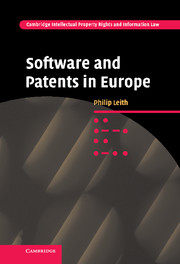Book contents
- Frontmatter
- Contents
- List of figures
- Introduction
- 1 Software as machine
- 2 Software as software
- 3 Policy arguments
- 4 Software patent examination
- 5 Holding the line: algorithms, business methods and other computing ogres
- 6 The third way: between patent and copyright?
- 7 Conclusion: dealing with and harmonising ‘radical’ technologies
- Index
- Cambridge Intellectual Property and Information Law
1 - Software as machine
Published online by Cambridge University Press: 22 July 2009
- Frontmatter
- Contents
- List of figures
- Introduction
- 1 Software as machine
- 2 Software as software
- 3 Policy arguments
- 4 Software patent examination
- 5 Holding the line: algorithms, business methods and other computing ogres
- 6 The third way: between patent and copyright?
- 7 Conclusion: dealing with and harmonising ‘radical’ technologies
- Index
- Cambridge Intellectual Property and Information Law
Summary
We sense that we know ‘technology’ when we see it. And no doubt that is correct, most of the time. But it is not correct all of the time. Therein lies the delusion. You can prove that for yourself by trying to find a definition of ‘technology’ that everybody can agree on. The more you try, the more you will discover what a horribly imprecise concept it is.
The problem: invention and the definition of technology
A prediction: within the next decade or so it will be possible to gain patent protection for software in the widest sense across all of Europe. Another prediction: algorithms which are not tied to any specific computer implementation will be openly protectable, as will business methods.
A prediction that software will be protectable is hardly adventurous, since, as Beresford has argued, such patents have been granted by the European Patent Office for some years now. Beresford's thesis is that it was only a general misconception which led to a belief that ‘computer-implemented inventions’ were not protectable: he pointed out that a reading of the EPO's annual report from 1994 noted that 11,000 such patents had been granted and only 100 refused. Now, a large number of patents – which are best described as ‘software patents’ – are entering the national phases of European EPO member states in a variety of technical fields.
- Type
- Chapter
- Information
- Software and Patents in Europe , pp. 6 - 38Publisher: Cambridge University PressPrint publication year: 2007



